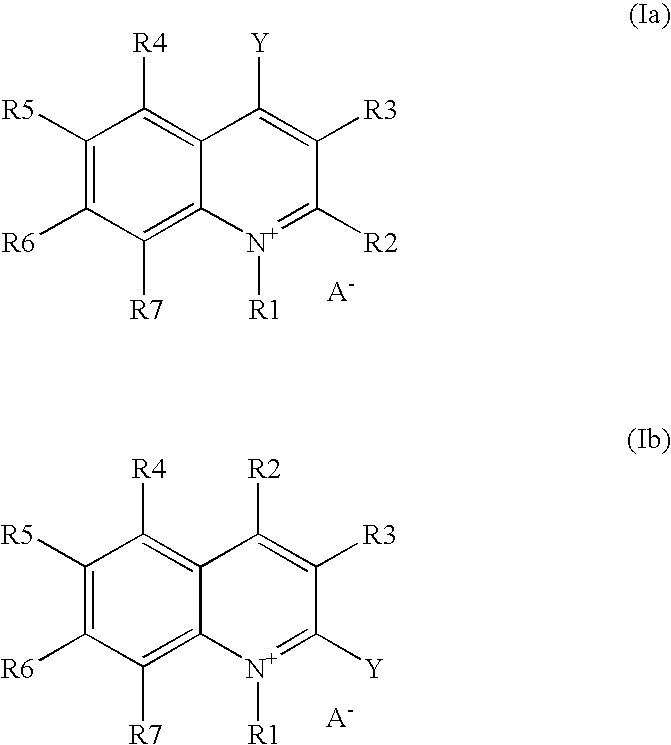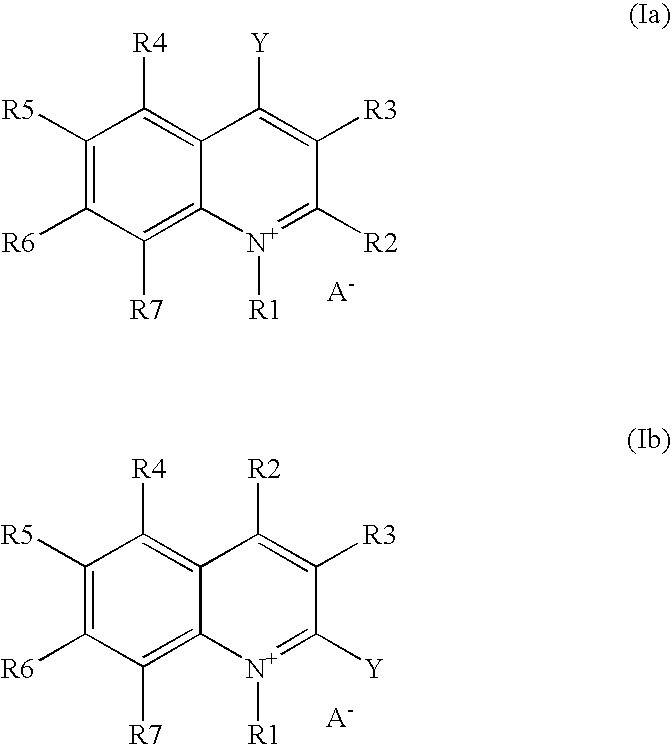Dye compositions containing quinolinium salts
a technology of quinolinium salt and composition, which is applied in the field of dye compositions, can solve the problems of unsatisfactory fastness of colors, allergic reactions in suitably disposed persons, damage to fibers, etc., and achieve the effect of safe and uniform dyeing and good fastness
- Summary
- Abstract
- Description
- Claims
- Application Information
AI Technical Summary
Benefits of technology
Problems solved by technology
Method used
Image
Examples
examples 1 to 7
Hair Dye Composition
[0030]
Component (A1):Compound of formula (Ia) or (Ib)Amount according to Table IDecylglucoside4.0 gEthylenediamine tetraacetate disodium salt0.2 gEthanol5.0 gWater, desalinatedto 100.0 g
[0031]
Component (A2):Compound with nucleophilicreaction centerAmount according to Table IDecylglucoside4.0 gEthylenediamine tetraacetate disodium salt0.2 gEthanol5.0 g25% aqueous ammonia solution6.0 gWater, desalinatedto 100.0 g
[0032]The component (A1) and the component (A2) are mixed with each other in a ratio of 1:1. The ready-to-apply hair dye mixture (A) is applied to the hair and is distributed uniformly with a brush. After an acting time of 30 minutes at 40° C. the hair is washed with a shampoo, subsequently rinsed with lukewarm water and then dried.
[0033]The amounts used and the dyed hair colors produced are tabulated in Table I.
examples 8 to 14
Hair Dye Composition
[0034]
Component (A1):Compound of formula (Ia) or (Ib)Amount according to Table IICocoamidopropylbetaine7.5 gEthanol5.0 gWater, desalinatedto 100.0 g
[0035]
Component (A2):Compound with nucleophilicreaction centerAmount according to Table IICocoamidopropylbetaine7.5 gEthanol5.0 g25% aqueous ammonia solution6.0 gWater, desalinatedto 100.0 g
[0036]The component (A1) and the component (A2) are mixed with each other in a ratio of 1:1. The ready-to-apply hair dye mixture (A) is applied to the hair and is distributed uniformly with a brush. After an acting time of 30 minutes at 40° C. the hair is washed with a shampoo, subsequently rinsed with lukewarm water and then dried.
[0037]The amounts used and the dyed hair colors produced are tabulated in Table II.
examples 15 to 24
Hair Dye Composition
[0038]
Component (A1):Compound of formula (Ia) or (Ib)Amount according to Table IIICetylstearyl alcohol12.0 gPolyethylene glycol octadecyl ether2.5 g(Brij ® 78P of Fluka)Water, desalinatedto 100.0 g
[0039]
Component (A2):Compound with nucleophilicreaction centerAmount according to Tables I-IIICetylstearyl alcohol12.0 gPolyethylene glycol octadecyl ether2.5 g(Brij ® 78P of Fluka)Water, desalinatedto 100.0 g
[0040]The cetyl stearyl alcohol is melted at 80° C. to make the components (A1) and (A2). The polyethylene glycol octadecyl ether is heated with 95% of the water and added to the melted cetyl stearyl alcohol. A cream results from this procedure. The compound with the nucleophilic reaction center or the compound of formula (Ia) or (Ib) is subsequently added with the remaining water at room temperature.
[0041]Then component (A1) and the component (A2) are mixed with each other in a ratio of 1:1. The pH of the resulting mixture is adjusted by addition of a 25% aqueous ...
PUM
| Property | Measurement | Unit |
|---|---|---|
| temperature | aaaaa | aaaaa |
| temperature | aaaaa | aaaaa |
| pH | aaaaa | aaaaa |
Abstract
Description
Claims
Application Information
 Login to View More
Login to View More - R&D
- Intellectual Property
- Life Sciences
- Materials
- Tech Scout
- Unparalleled Data Quality
- Higher Quality Content
- 60% Fewer Hallucinations
Browse by: Latest US Patents, China's latest patents, Technical Efficacy Thesaurus, Application Domain, Technology Topic, Popular Technical Reports.
© 2025 PatSnap. All rights reserved.Legal|Privacy policy|Modern Slavery Act Transparency Statement|Sitemap|About US| Contact US: help@patsnap.com



